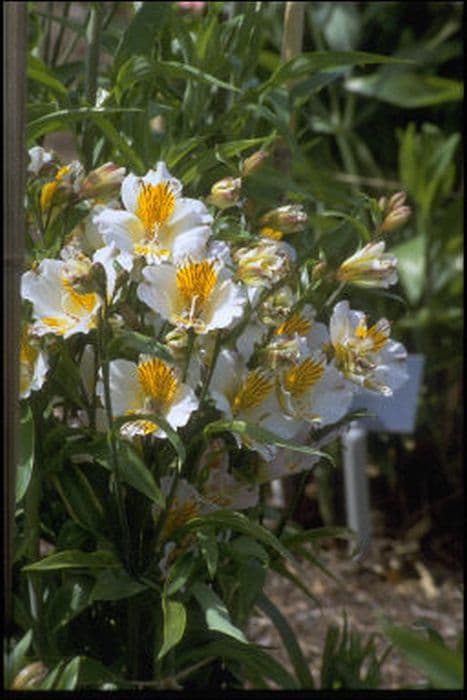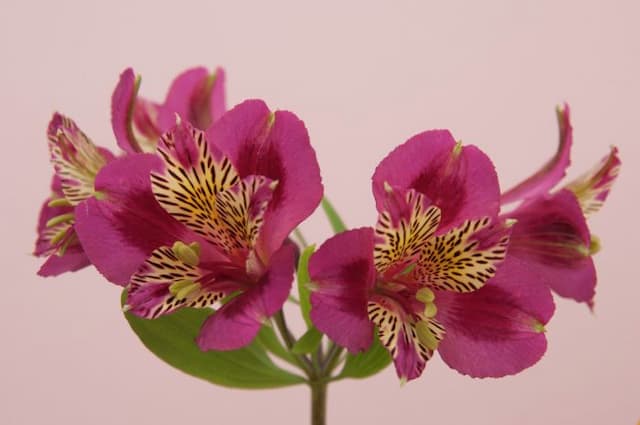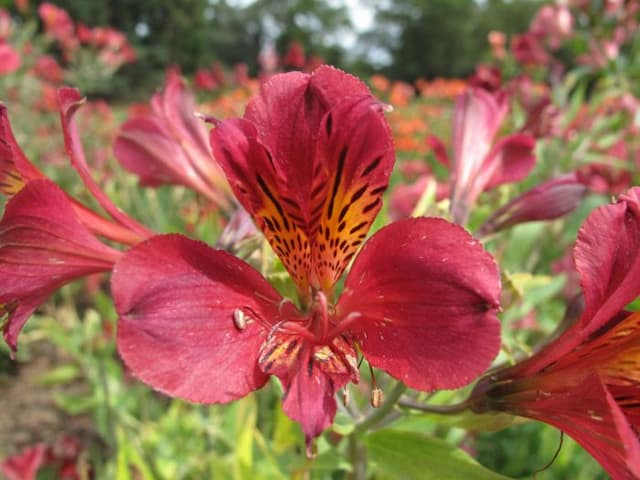Peruvian Lily Alstroemeria Summer Party = 'Tessumpar' (Summer Paradise Series)
![Peruvian lily [Summer Party]](/_next/image?url=https%3A%2F%2Fplants-admin.emdemapps.com%2Fimages%2Fplants%2F%2Fimages%2F604b536a19226.png&w=3840&q=75)
ABOUT
The Alstroemeria Summer Party, also known as the Peruvian Lily, from the Summer Paradise Series, is a plant that's praised for its striking appearance and vibrant colors. It presents a lush array of foliage, with slender green leaves that often display a twisted or spiraled form. The leaves provide a backdrop for the plant's primary attraction – stunning flowers that appear in clusters. These blossoms are a visual delight, showcasing a mix of pink and orange hues with distinctively contrasting streaks and flecks typically in darker tones that can include shades of brown, yellow, or maroon. Each petal exhibits a unique pattern, often with symmetrical marks that draw the eye. The petals have a slightly trumpeted shape, curving outwards from a central point to display their full glory. Adding to their charm, the inner sections of the flowers have yellow to cream-colored throats, transitioning into the main colors of the petals, which is a characteristic feature of the Alstroemeria genus. This charming blend of colors provides a warm, summery feel, evoking the essence of a joyful summer party – true to its name. Furthermore, the Peruvian Lily typically shows off a bushy, dense growth habit with an abundance of flowers that can bloom for an extended period, often throughout the summer months, providing long-lasting visual interest. With its captivating display, the Alstroemeria Summer Party is admired for its ability to attract attention in any garden or as part of a cut flower arrangement, bringing a touch of festive elegance to any setting.
About this plant
 Names
NamesFamily
Alstroemeriaceae.
Synonyms
Peruvian Lily, Lily of the Incas, Alstroemeria, Parrot Lily.
Common names
Alstroemeria 'Tessumpar'
 Characteristics
CharacteristicsLife cycle
Perennials
Foliage type
Deciduous
Color of leaves
Green
Flower color
Mixed
Height
2-3 feet (60-90 cm)
Spread
1-2 feet (30-60 cm)
Plant type
Herb
Hardiness zones
7
Native area
South America
Benefits
 General Benefits
General Benefits- Long Blooming Period: Produces flowers for an extended period, typically from early summer to late fall.
- Attracts Pollinators: The vibrant flowers attract bees, butterflies, and other beneficial pollinators to your garden.
- Drought Tolerant: Once established, it is quite tolerant of dry conditions, reducing the need for frequent watering.
- Low Maintenance: Requires minimal care once planted and established, making it a good choice for busy gardeners.
- Colorful Displays: Offers an array of beautiful colors, adding aesthetic appeal to garden spaces and bouquets.
- Good Cut Flowers: The blooms are long-lasting when cut, making them excellent for floral arrangements.
- Perennial Growth: As a perennial plant, it returns year after year, saving the cost and effort of replanting annually.
- Cold Hardy: It can survive and thrive in cooler temperatures, which makes it suitable for a variety of climates.
 Medical Properties
Medical PropertiesThis plant is not used for medical purposes.
 Air-purifying Qualities
Air-purifying QualitiesThis plant is not specifically known for air purifying qualities.
 Other Uses
Other Uses- The Alstroemeria, also known as Peruvian Lily, can be used in floral photography to practice macro photography skills and capture intricate details due to its vivid colors and patterns.
- The plant can provide inspiration for artists and designers, who may use the unique color combinations and shapes of its flowers as a basis for textile patterns, paintings, or other forms of artwork.
- Peruvian Lily petals can be used in crafts, such as making homemade greeting cards or bookmarks, by pressing and drying the flowers to preserve their beauty.
- In educational settings, the plant can be used to demonstrate plant propagation techniques to students, as Peruvian Lily can be propagated easily through division.
- The plant is often used as a living ornament during celebrations or events, with its potted form serving as a centerpiece for tables or decoration for entrances.
- Peruvian Lilies can be employed in culinary presentations, as their non-toxic petals can add a decorative touch to salads and desserts.
- These flowers can serve as a natural colorant for crafting homemade soaps or candles, giving them a distinctive hue and delicate floral essence.
- Hobbyist gardeners may use the Alstroemeria as a companion plant to create aesthetically pleasing and biodiverse garden arrangements with other perennials.
- The vibrant flowers can be used in photography projects as a means to explore color theory, understanding how different hues interact with each other.
- Peruvian Lilies can also be incorporated into nature-based therapy practices, where tending to and observing the growth of the flowers may provide relaxation and mental well-being.
Interesting Facts
 Feng Shui
Feng ShuiThe Peruvian lily is not used in Feng Shui practice.
 Zodiac Sign Compitability
Zodiac Sign CompitabilityThe Peruvian lily is not used in astrology practice.
 Plant Symbolism
Plant Symbolism- Friendship: Alstroemeria, commonly known as Peruvian lily or lily of the Incas, often symbolizes strong bonds of friendship due to the flower's long-lasting nature and the intertwined growth of its stems.
- Devotion: Much like the firm connection between friends or partners, the Peruvian lily signifies devotion and the commitment to support one another over time.
- Wealth and Prosperity: With its lush blooms and multiple flowers per stem, the Peruvian lily is often associated with wealth and an abundance of blessings.
- Achievement: The flower can represent personal growth and the achievement of aspirations, much like its vigorous growth in the summer months.
- Mutual Support: The intertwined stems of the Peruvian lily can also symbolize the idea of mutual support, suggesting that individuals thrive when they work together.
- Fortitude: Given the resilience of the Peruvian lily, which allows it to thrive in various conditions, it can also be a symbol of fortitude and adaptability in the face of adversity.
 Water
WaterPeruvian Lily requires consistent moisture, so water it thoroughly whenever the top inch of soil feels dry to the touch. During peak growth in spring and summer, this is typically once or twice a week. Use about one gallon of water per plant for each watering session to ensure the soil is moistened well but not waterlogged. In hot weather, watering frequency may increase due to quicker evaporation. During winter or dormant periods, reduce watering, but don't let the soil become completely dry.
 Light
LightPeruvian Lily thrives in full sun to partial shade. Placing it in a spot that receives at least six hours of sunlight a day is ideal. Too much shade can reduce flowering, but in very hot climates, afternoon shade can help protect the plant from excessive heat.
 Temperature
TemperaturePeruvian Lily does best in temperatures ranging from 65 to 80 degrees Fahrenheit. It can survive minimum temperatures down to around 25 degrees Fahrenheit, but frost can damage the plant. Ideal growing conditions prevent exposure to temperatures exceeding 90 degrees Fahrenheit, as excess heat may stress the plant.
 Pruning
PruningPrune Peruvian Lily to encourage vigorous growth and more blooms. Deadhead spent flowers regularly to promote continuous blooming throughout the season. Cut back the foliage to the ground level in late fall or early winter after the first frost to clean up the plant and prepare it for next year's growth. Pruning is typically done once at the end of the blooming season.
 Cleaning
CleaningAs needed
 Soil
SoilPeruvian Lily requires well-draining soil with a mix of loam, sand, and organic matter; it thrives in slightly acidic to neutral pH, between 6.0 and 7.0.
 Repotting
RepottingPeruvian Lilies should be repotted every 2-3 years to rejuvenate the soil and accommodate the growth of their tuberous roots.
 Humidity & Misting
Humidity & MistingPeruvian Lily prefers moderate to high humidity levels but can adapt to average room humidity when grown indoors.
 Suitable locations
Suitable locationsIndoor
Provide bright indirect light and keep the soil consistently moist.
Outdoor
Plant in a sheltered spot with partial sun and well-draining soil.
Hardiness zone
7-10 USDA.
 Life cycle
Life cycleThe Alstroemeria 'Tessumpar', also known as Peruvian Lily, starts its life as a rhizomatous tuber that sprouts into new growth in spring. Foliage emerges first, followed by the stalks that will bear the flowering heads. During the summer months, blooms appear in clusters, revealing the distinctive, colorful, and often speckled flowers that may continually appear through early fall with proper care. After flowering, the plant enters a period of dormancy, especially in colder climates, where the foliage will die back with the onset of frost and the tubers will overwinter underground. In milder climates, the plant may retain some of its foliage year-round, though growth slows significantly. It completes its life cycle once again in spring when temperatures rise, and the cycle repeats annually.
 Propogation
PropogationPropogation time
Early Spring
The Alstroemeria Summer Party, part of the Summer Paradise Series, is most commonly propagated through division, which is typically done in the spring. To propagate by division, the clumps of rhizomes should be carefully lifted from the ground once the danger of frost has passed. It's important to handle the brittle roots gently to avoid damage. The clumps can then be divided by gently teasing apart the rhizomes and ensuring each new piece has a section of root and at least one growth point. These divisions should be replanted at the same depth they were growing at before and watered thoroughly to help establish the new plants. This method effectively multiplies the plants while preserving the characteristics of the 'Tessumpar' cultivar.







![Peruvian lily [Inca Coral]](/_next/image?url=https%3A%2F%2Fplants-admin.emdemapps.com%2Fimages%2Fplants%2F%2Fimages%2F604b5b79b85ce.png&w=640&q=75)
![Peruvian lily [Inca Exotica]](/_next/image?url=https%3A%2F%2Fplants-admin.emdemapps.com%2Fimages%2Fplants%2F%2Fimages%2F604b5ec0e34a9.png&w=640&q=75)
![Peruvian lily [Inca Milk]](/_next/image?url=https%3A%2F%2Fplants-admin.emdemapps.com%2Fimages%2Fplants%2F%2Fimages%2F604b5f14b0b6a.png&w=640&q=75)